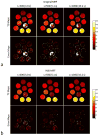Multiscale reconstruction for MR fingerprinting
- PMID: 26132462
- PMCID: PMC4696924
- DOI: 10.1002/mrm.25776
Multiscale reconstruction for MR fingerprinting
Abstract
Purpose: To reduce the acquisition time needed to obtain reliable parametric maps with Magnetic Resonance Fingerprinting.
Methods: An iterative-denoising algorithm is initialized by reconstructing the MRF image series at low image resolution. For subsequent iterations, the method enforces pixel-wise fidelity to the best-matching dictionary template then enforces fidelity to the acquired data at slightly higher spatial resolution. After convergence, parametric maps with desirable spatial resolution are obtained through template matching of the final image series. The proposed method was evaluated on phantom and in vivo data using the highly undersampled, variable-density spiral trajectory and compared with the original MRF method. The benefits of additional sparsity constraints were also evaluated. When available, gold standard parameter maps were used to quantify the performance of each method.
Results: The proposed approach allowed convergence to accurate parametric maps with as few as 300 time points of acquisition, as compared to 1000 in the original MRF work. Simultaneous quantification of T1, T2, proton density (PD), and B0 field variations in the brain was achieved in vivo for a 256 × 256 matrix for a total acquisition time of 10.2 s, representing a three-fold reduction in acquisition time.
Conclusion: The proposed iterative multiscale reconstruction reliably increases MRF acquisition speed and accuracy. Magn Reson Med 75:2481-2492, 2016. © 2015 Wiley Periodicals, Inc.
Keywords: Compressed Sensing; Fingerprinting; Multiscale Image Reconstruction; Parameter Mapping.
© 2015 Wiley Periodicals, Inc.
Figures









References
-
- Hennig J, Weigel M, Scheffler K. Calculation of flip angles for echo trains with predefined amplitudes with the extended phase graph (EPG)-algorithm: principles and applications to hyperecho and TRAPS sequences. Magn Reson Med. 2004;51:68–80. - PubMed
-
- Doneva M, Börnert P, Eggers H, Stehning C, Sénégas J, Mertins A. Compressed sensing reconstruction for magnetic resonance parameter mapping. Magn Reson Med. 2010;64:1114–1120. - PubMed
-
- Block KT, Uecker M, Frahm J. Model-based iterative reconstruction for radial fast spin-echo MRI. IEEE Trans Med Imaging. 2009;28:1759–69. - PubMed
MeSH terms
Grants and funding
LinkOut - more resources
Full Text Sources
Other Literature Sources
Medical
Miscellaneous

